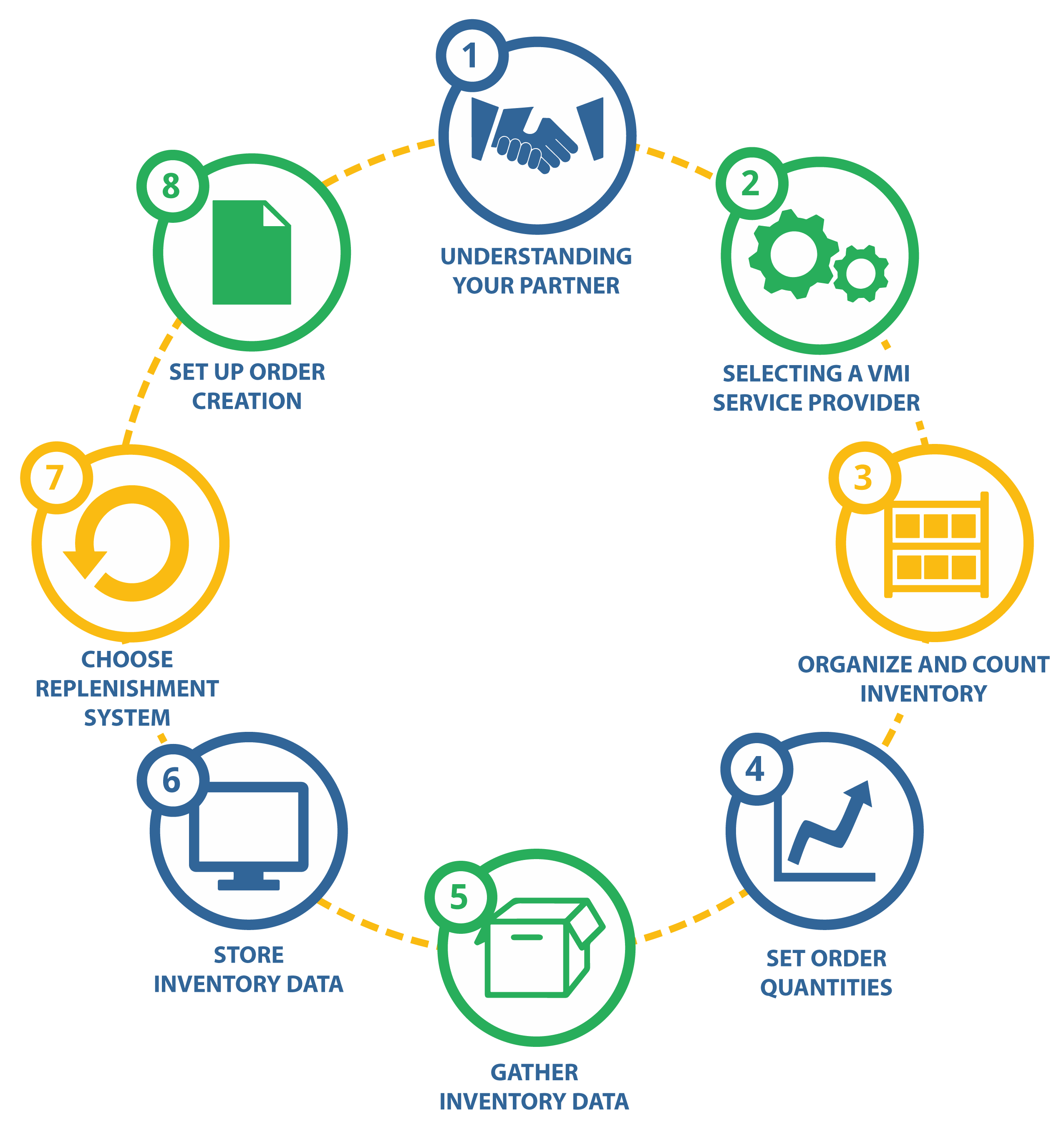-
Products
- SAS - Singalarity Authentication Server & Token Management Server
- TAE - Troubleshooting Analytic Engine
- FSOC - Forensic Security Operations Center
- ST Engineering Data Diode - Secured Data Transfer Gateway
- Rnext - Business Management Platform
- Rnext - QRPay Intra-Gateway
- Rnext - Fintech Solution Platform
- Services
- Industries
- News & Analysis
- Opportunities
- About us
The Benefits of Evolved Vendor Managed Inventory Model
Vendor managed inventory is a family of business models in which the buyer of a product (business) provides certain information to a vendor (supply chain) supplier of that product and the supplier takes full responsibility for maintaining an agreed inventory the material, usually at the buyer's consumption location (usually a store).

Vendor Managed Inventory Model: A Quick Back Story

When I was Materials Manager at Maricopa County, Arizona, the second largest county in the country, I introduced Vendor Managed Inventory. I took our line of fasteners: bolts, nuts screws and washers and put them in one location in the Warehouse. I called Fastenal, who specializes in Vendor Managed Inventory (VMI) for fasteners, in to see what we can do together. VMI is all about collaboration. We came to the conclusion, that each fastener type be put in a slot in a special rack that Fastenal gave us. We only paid for fasteners as we used them. There was a signed contract with agreed upon inventory levels. No Purchase Orders were used. There was no inventory carrying costs or concern for inventory turns. Fastenal would come in each week, check our inventory levels, and re-fill the rack based on agreed upon inventory amounts. We never ran out of or had too much inventory. It was a “win-win” partnership
The Evolved Vendor Managed Inventory Model
The use of Vendor Managed Inventory model has gained acceptance in many industries. What was once thought of as an experiment, has now become the preferred way of doing business. The Ford Motor Company led by Henry Ford and The Toyota Manufacturing Company led the way to VMI.
Cutting the Right Costs with Technology by Sourcing Innovation
In an article in Industry Week, which advocated that you cut the fat, not the limb, reminded us that there are a number of strategic projects, based on appropriate supply chain technology that can provide a far greater internal rate of return than merely slashing costs. Vendor Managed Inventory and longer-term collaborations offer opportunities for both parties.
Further, Fleet Equipment magazine identifies six emerging trends in the dynamic commercial vehicle aftermarket. One of these trends deals with utilizing the latest inventory management techniques to manage customers to “lean”. In addition to more prevalent online ordering, many suppliers now offer Vendor Managed Inventory (VMI).
- VMI can automatically generate recommended orders based on mutually agreed upon objectives and information sent by the customer.
- VMI is an excellent option for many dealers and distributors as it has the ability to increase inventory turns, reduce customer returns, reduce administrative costs and reduce lost sales.
- VMI is an opportunity for suppliers to refine inventory control for their distribution channels, and ultimately, lower costs to the end user. We have an ongoing emphasis to continuously improve this channel and streamline the process to make it more effective and responsive.”
A real world example of Vendor Managed Inventory in play is electrical products company Leviton Manufacturing. Leviton selected a vendor managed inventory solution from VMI specialist Datalliance as a tool to help them run their business more effectively and giving them a competitive edge by creating a collaborative working relationship with key trading partners. "By moving to Datalliance we are gaining a more robust VMI solution that will better serve the needs of our customers," said Mark Richards, Leviton's director of e-commerce. "We also look forward to opportunities to reduce the overall cost and effort of VMI by choosing a more streamlined solution."
What is Vendor Managed Inventory?
Vendor managed inventory is a family of business models in which the buyer of a product (business) provides certain information to a vendor (supply chain) supplier of that product and the supplier takes full responsibility for maintaining an agreed inventory the material, usually at the buyer's consumption location (usually a store). A third-party logistics provider can also be involved to make sure that the buyer has the required level of inventory by adjusting the demand and supply gaps.
As a symbiotic relationship, vendor managed inventory makes it less likely that a business will unintentionally become out of stock of a good and reduces inventory supply chain. Furthermore, vendor (supplier) representatives in a store benefit the vendor by ensuring the product is properly displayed and store staff are familiar with the features of the product line, all the while helping to clean and organize their product lines for the store.
One of the keys to making VMI work is shared risk. In some cases, if the inventory does not sell, the vendor (supplier) will repurchase the product from the buyer (retailer). In other cases, the product may be in the possession of the retailer but is not owned by the retailer until the sale takes place, meaning that the retailer simply houses (and assists with the sale of) the product in exchange for a predetermined commission or profit (sometimes referred to as consignment stock). A special form of this commission business is scan-based trading where VMI is usually applied but its use is not mandatory.
This is one of the successful business models used by Walmart and many other big box retailers. Oil companies often use technology to manage the gasoline inventories at the service stations that they supply (Petrolsoft). Home Depot uses the technique with larger suppliers of manufactured goods. VMI helps foster a closer understanding between the supplier and manufacturer by using Electronic Data Interchange (EDI) formats, EDI software and statistical methodologies to forecast and maintain correct inventory in the supply chain.
Vendors benefit from more control of displays and more customer contact for their employees; retailers benefit from reduced risk, better store staff knowledge (which builds brand loyalty for both the vendor and the retailer), and reduced display maintenance outlays.
Consumers benefit from knowledgeable store staff who are in frequent and familiar contact with the manufacturer (vendor) representatives when parts or service are required. Store staff have good knowledge of most product lines offered by the entire range of vendors. They can help the consumer choose from competing products for items most suited to them and offer service support being offered by the store.
Software to Manage Vendor Managed Inventory
Web-based vendor managed inventory (WEB VMI) provides live and immediate access to inventories throughout the supply chain, increasing supply reliabilities while taking costs out of the supply chain. Customers are assured of deliveries that better meet changing replenishment needs, for both base and opportunistic production levels, while also reducing inventory-related working capital needs. Suppliers also gain a cost advantage by enabling more effective make-to-order and just-in-time manufacturing strategies, aligning production with the latest real-time market demands and eliminating unnecessary transport delays.
Significant value results from the application of web-based vendor managed inventory, which provides critical insight into usage patterns and forecast consumption to help match production and deliveries with exact customer demands. Additionally, a WEB-VMI solution removes barriers to inter-company transactions through database connectivity or formatted message communication options with enterprise systems, such as SAP R/3™, JD Edwards OneWorld™ and others.
Core Benefits of the Evolved Vendor Managed Inventory with Technology Application
- Data entry errors are greatly reduced due to computer to computer communications. The speed of the processing is also improved.
- Both parties are interested in giving better service levels to the end customer. Having the correct item in stock when the end customer needs it, benefits all parties involved.
- A true partnership is formed between the Manufacturer and the Distributor. They work closer together and strengthen their ties. This benefits of a stronger partnership goes beyond VMI.
- Stabilize the timing of Purchase Orders - PO's are now generated on a predefined basis. Example: A once/twice Weekly purchase order cycle.
Distributor Benefits in Vendor Managed Inventory
- The goal is to have an improvement in Fill Rates from the manufacturer and to the end customer. Also, a decrease in stock outs and a decrease in overall inventory levels
- Planning and ordering cost will decrease due to the responsibility being shifted to the Manufacturer.
- The overall service level is improved by having the right product at the right time.
- The manufacturer is more focused than ever in providing great service to the distributor and the end customer.
Manufacturer's Benefit from Evolved VMI
- Visibility to the Distributors Point of Sale data makes forecasting for the manufacturer easier.
Source : http://cerasis.com
Share:

